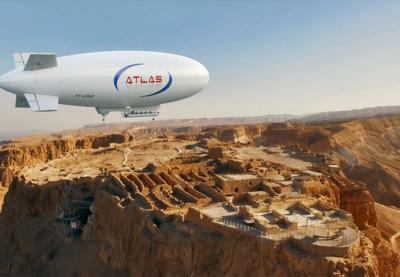Thu, Sep 10, 2020
This Location Allows Relatively Easy Transportation Of Materials And Components
Newly-established Israeli company, Atlas LTA Advanced Technology Ltd, has brought together leading experts from around the world in the unique field of lighter-than-air technology. The core team members have extensive experience in building airships and aerostats for all kinds of purpose, and together offer a solid technical background for the company’s current production activities and future developments.

Atlas's main goal is to introduce its green airships into everyday life, thereby reducing poisonous carbon emissions. The company is active in many fields, delivering practical, cost-effective solutions in the form of modern airships and aerostats. For example, Atlas-6/11 sightseeing airships are sparking curiosity at national parks and historic landmarks all over the world.
The advantages of the lighter-than-air technologies proposed by Atlas can also be clearly seen in the context of communications and surveillance missions. High altitude, long range, and unprecedented endurance of unmanned flight all contribute to making tethered aerostats or solar-powered airships a unique and highly-effective solution in several instances where traditional aircraft cannot be used. Besides the obvious economic advantages, their performance does not require the burning of any traditional fuel.
Atlas's flagship project is to build a new family of large-capacity transport airships, which will be capable of carrying oversized and overweight cargo of up to 165 tons, using safe helium buoyancy and dynamic lift made possible by low-emission hybrid-electric propulsion. Named ATLANT, this airship will significantly reduce transportation costs and will eventually change the world of cargo transportation. Since it does not require any special infrastructure, it can land in a desert, on water or even Arctic ice, making many hard-to-reach destinations much more accessible.
Based on the company’s latest innovations and practical achievements, this ambitious project applies important lessons learnt from its predecessors. Use of hydrogen as its fuel will make ATLANT the first zero-emission, large-capacity cargo aircraft. In the future, when the rules permit, it can be turned into a fully-autonomous unmanned cargo vehicle – the world’s largest UAV. The ATLANT is expected to be emission free within the next six to seven years.
More News
Aero Linx: International Federation of Airworthiness (IFA) We aim to be the most internationally respected independent authority on the subject of Airworthiness. IFA uniquely combi>[...]
Ultrahigh Frequency (UHF) The frequency band between 300 and 3,000 MHz. The bank of radio frequencies used for military air/ground voice communications. In some instances this may >[...]
A Few Questions AND Answers To Help You Get MORE Out of ANN! 1) I forgot my password. How do I find it? 1) Easy... click here and give us your e-mail address--we'll send it to you >[...]
From 2019 (YouTube Edition): Learning To Paint Without Getting Any On Your Hands PPG's Aerospace Coatings Academy is a tool designed to teach everything one needs to know about all>[...]
Also: Sustainable Aircraft Test Put Aside, More Falcon 9 Ops, Wyoming ANG Rescue, Oreo Cookie Into Orbit Joby Aviation has reason to celebrate, recently completing its first full t>[...]
 ANN's Daily Aero-Linx (05.06.25)
ANN's Daily Aero-Linx (05.06.25) ANN's Daily Aero-Term (05.06.25): Ultrahigh Frequency (UHF)
ANN's Daily Aero-Term (05.06.25): Ultrahigh Frequency (UHF) ANN FAQ: Q&A 101
ANN FAQ: Q&A 101 Classic Aero-TV: Virtual Reality Painting--PPG Leverages Technology for Training
Classic Aero-TV: Virtual Reality Painting--PPG Leverages Technology for Training Airborne 05.02.25: Joby Crewed Milestone, Diamond Club, Canadian Pilot Insurance
Airborne 05.02.25: Joby Crewed Milestone, Diamond Club, Canadian Pilot Insurance



